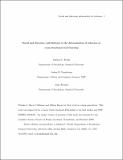| dc.contributor.author | Frank, Michael C. | |
| dc.contributor.author | Tenenbaum, Joshua B. | |
| dc.contributor.author | Fernald, Anne | |
| dc.date.accessioned | 2015-01-15T15:03:51Z | |
| dc.date.available | 2015-01-15T15:03:51Z | |
| dc.date.issued | 2013-01 | |
| dc.identifier.issn | 1547-5441 | |
| dc.identifier.issn | 1547-3341 | |
| dc.identifier.uri | http://hdl.handle.net/1721.1/92874 | |
| dc.description.abstract | How do children infer the meanings of their first words? Even in infant-directed speech, object nouns are often used in complex contexts with many possible referents and in sentences with many other words. Previous work has argued that children can learn word meanings via cross-situational observation of correlations between words and their referents. While cross-situational associations can sometimes be informative, social cues to what a speaker is talking about can provide a powerful shortcut to word meaning. The current study takes steps toward quantifying the informativeness of cues that signal speakers' chosen referent, including their eye-gaze, the position of their hands, and the referents of their previous utterances. We present results based on a hand-annotated corpus of 24 videos of child-caregiver play sessions with children from 6 to 18 months old, which we make available to researchers interested in similar issues. Our analyses suggest that although they can be more useful than cross-situational information in some contexts, social and discourse information must also be combined probabilistically to be effective in determining reference. | en_US |
| dc.description.sponsorship | National Science Foundation (U.S.) (NSF #DDRIG #0746251) | en_US |
| dc.description.sponsorship | United States. Department of Education (Jacob K. Javits Graduate Fellowship) | en_US |
| dc.language.iso | en_US | |
| dc.publisher | Taylor & Francis | en_US |
| dc.relation.isversionof | http://dx.doi.org/10.1080/15475441.2012.707101 | en_US |
| dc.rights | Creative Commons Attribution-Noncommercial-Share Alike | en_US |
| dc.rights.uri | http://creativecommons.org/licenses/by-nc-sa/4.0/ | en_US |
| dc.source | Stanford University web domain | en_US |
| dc.title | Social and Discourse Contributions to the Determination of Reference in Cross-Situational Word Learning | en_US |
| dc.type | Article | en_US |
| dc.identifier.citation | Frank, Michael C., Joshua B. Tenenbaum, and Anne Fernald. “Social and Discourse Contributions to the Determination of Reference in Cross-Situational Word Learning.” Language Learning and Development 9, no. 1 (January 2013): 1–24. | en_US |
| dc.contributor.department | Massachusetts Institute of Technology. Department of Brain and Cognitive Sciences | en_US |
| dc.contributor.mitauthor | Tenenbaum, Joshua B. | en_US |
| dc.relation.journal | Language Learning and Development | en_US |
| dc.eprint.version | Original manuscript | en_US |
| dc.type.uri | http://purl.org/eprint/type/JournalArticle | en_US |
| eprint.status | http://purl.org/eprint/status/NonPeerReviewed | en_US |
| dspace.orderedauthors | Frank, Michael C.; Tenenbaum, Joshua B.; Fernald, Anne | en_US |
| dc.identifier.orcid | https://orcid.org/0000-0002-1925-2035 | |
| mit.license | OPEN_ACCESS_POLICY | en_US |
| mit.metadata.status | Complete | |
